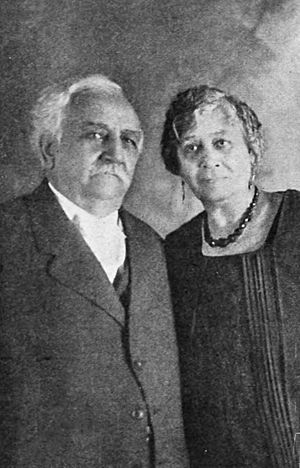Thomas E. Miller facts for kids
Quick facts for kids
Thomas Ezekiel Miller
|
|
|---|---|
 |
|
| Member of the U.S. House of Representatives from South Carolina's 7th district |
|
| In office September 24, 1890 – March 3, 1891 |
|
| Preceded by | William Elliot |
| Succeeded by | William Elliot |
| Personal details | |
| Born | June 17, 1849 Ferrebeeville, South Carolina, United States |
| Died | April 8, 1938 (aged 88) Charleston, South Carolina, United States |
| Political party | Republican |
| Spouse | Anna M. Hume |
| Alma mater | Lincoln University (Pennsylvania) |
| Profession | Educator, attorney |
Thomas Ezekiel Miller (June 17, 1849 – April 8, 1938) was an American educator, lawyer, and politician. He was a strong leader who fought for civil rights in the American South. Miller was one of the few African Americans elected to Congress from the South during a tough time called the Jim Crow era. This was a period when laws made it very hard for Black people to vote.
Miller served as a school commissioner and a state lawmaker in South Carolina. He also became a U.S. Representative. Later, he was the first president of South Carolina State University. This university was created as a historically black college to provide education for Black students.
Contents
Early Life and Education
Thomas Miller was born in Ferrebeeville, South Carolina. He was adopted by Richard and Mary Ferrebee Miller, who were formerly enslaved but became free by 1850. His birth parents were a white father and a mixed-race mother. His mother was the daughter of Judge Thomas Heyward, Jr., who signed the Declaration of Independence.
In 1851, his family moved to Charleston. There, Miller went to a school for free Black children. After the Civil War ended, he moved to Hudson, New York. Even though he looked like he could be white, Miller chose to identify as Black. He returned to the South to help the freedmen, who were newly freed enslaved people.
Miller received a scholarship to attend Lincoln University (Pennsylvania). This was a historically black college in Pennsylvania. He graduated from Lincoln University in 1872.
After college, Miller returned to South Carolina. He was appointed as a school commissioner for Beaufort County in 1872. He then studied law at the South Carolina College. Black students were allowed to attend this college for the first time during this period. Miller graduated in 1875 and became a lawyer that same year.
Marriage and Family Life
Thomas Miller married Anna Hume. Together, they had nine children.
Political Career and Challenges
Miller was elected to the South Carolina House of Representatives in 1874. He served three terms until 1880. Then, he was elected to the South Carolina Senate in 1880, serving until 1882. He was nominated to be lieutenant governor but did not run.
Miller faced challenges from both Black and white communities. Some Black political rivals questioned his heritage. White colleagues sometimes treated him differently because he identified as Black. Despite these issues, he became chairman of the state Republican Party in 1884.
In 1888, Miller ran for U.S. Representative. He ran in the 7th Congressional District. This district was set up to include many Black voters. The Democratic candidate, William Elliot, was declared the winner. However, Miller argued that many Black voters were stopped from voting. This was due to a confusing "eight-box ballot" system.
The House Committee of Elections agreed with Miller. He was finally given his seat in Congress in 1890. However, he lost his re-election bid to William Elliot later that year.
Miller continued to fight for the rights of Black citizens. He was a delegate to the 1895 South Carolina constitutional convention. This convention was led by Governor Benjamin Tillman, who wanted to stop Black people from voting.
The new state constitution made it very hard for Black citizens to vote. It required longer residency, literacy tests given by white supervisors, poll taxes, and owning property worth $300. Miller and other Black delegates strongly opposed these rules. They shared their concerns with a national newspaper, the New York World. Even so, the new constitution passed. This stopped most Black voters from participating in elections for over 50 years.
Founding a College
Miller did get support from Governor Tillman to create a college for African Americans. In 1896, the Colored Normal, Industrial, Agricultural, and Mechanical College of South Carolina was established in Orangeburg. This historically black college later became South Carolina State University.
Miller was appointed as the college's first president. He resigned from his state representative position to take on this role. He remained active in politics. In 1910, he opposed the election of Coleman Blease as governor. After Blease won, he forced Miller to resign from the college presidency.
Miller moved back to Charleston from Orangeburg. He worked on various community projects. During World War I, he helped recruit 30,000 Black men to join the Armed Services.
From 1923 to 1934, Miller lived in Philadelphia. He then returned to Charleston, where he passed away on April 8, 1938. On his gravestone, he asked for these words to be written: "Not having loved the white less, but having felt the Negro needed me more." This showed his dedication to civil rights and his choice to identify as African American.
See also


